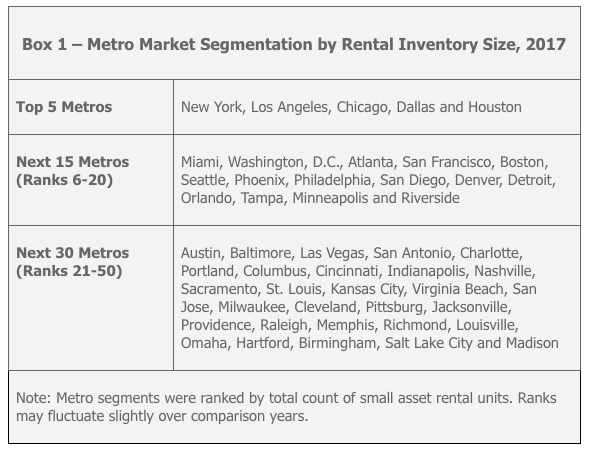Top Rental Markets for the Baby Boomer-Senior Segment

Rental demand for Baby Boomer-Senior renters is most concentrated in affordable, amenity-rich large apartment properties in smaller metros.
Large Multifamily in Smaller Metros Stands Out for Boomer-Senior Segment
Building upon our recent research on U.S. renter age segments, this blog examines housing demand from Baby Boomers and Seniors for rental properties across metro areas.
For a quick overview across U.S. urban areas, we look at the Top 50 MSAs grouped into segments based on rental inventory size (see Box 1). Boomers are defined as those born between 1946 and 1964, and Seniors are defined as those born before 1946, according to Pew Research Center’s cohort classifications.
The rise in rental popularity among Baby Boomers over the past decade has attracted much attention from multifamily stakeholders, but this demand surge goes toe-and-toe with the more care-dependent Senior segment, as shown below.
(Please click around for detailed chart information)
Renting attributes sync up well with the preferences of today’s greying population. A mix of lower real estate costs, a reduced need for space and lifestyle flexibility have made renting appealing to those in the Boomer-Senior segment.
Additionally, the ability to age in place is made easier by proximity to amenities and care-facilities — a factor that is most consistent with larger apartment properties.
As shown below, Boomer-Senior renters were concentrated in large multifamily buildings, especially in the smaller metros (Next 30) where their share of all adult renters reached nearly 42%. This is up from 35% across the Top 5 and Next 15 segments.¹
(Please click around for detailed chart information)
In comparison, the share of this age cohort within small apartment properties and single-family rentals was significantly lower, at about 25% across metro segments.
Top Destinations also Most Affordable to Rent
Examining demand shares in individual metros indicates a retiree preference toward smaller metro areas that also have lower rents relative to the national average.
As depicted below, Providence, Pittsburg, Milwaukee and Hartford, all of which fall into the Next 30 metro group and have rents below the national average, highlight the list of metros with the highest Boomer-Senior shares within small asset multifamily.
(Please click around for detailed chart information)
Similar patterns emerge for large multifamily properties. As shown below, smaller metros dominate the list of the 10 highest Boomer-Senior shares, topped again by Providence, with unit rents being the lowest nationally for this asset class.
(Please click around for detailed chart information)
Looking ahead, the Harvard Joint Centers for Housing Studies (JCHS) estimates an increase of around 6 million retiree households over the next 20 years.
For property operators, attracting this demand will require close attention to building-level amenities that assist aging in place. Much of the Senior renter demand will likely gravitate toward smaller metros with low housing costs.
1 All data is sourced from the American Community Survey (ACS), unless otherwise stated. ACS statistics are sample-based estimates of the compositional profile of the total population in the given year of data collection, and include a margin of error.


